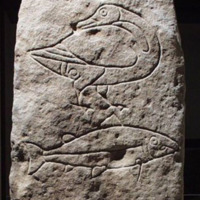Easterton of Roseisle Stone
Dublin Core
Title
Easterton of Roseisle Stone
Subject
An rare example of the Goose symbol can be seen on the Easterton Of Roseisle, Class I Pictish Symbol Stone from Moray, now housed in National Museum Scotland, Edinburgh.
Discovered in 1894 - a farmer ploughing his fields at Easterton farm, unearthed the top of a burial cist. The pictish stone formed the West side of the irregularly shaped cist.
It seems the stone had been re-used, as both sides, including the outermost side, exposed to the soil, are inscribed with pictish designs.
Outer aspect of stone, A large Crescent with notch (A bridge, or 'rainbow-arch' to some), above a crescent and v-rod, and mirror and comb.
Reverse side - A goose, with neck arched back over body, above a salmon.
The goose is a rare form of a pictish design, likely 5-6th Century in its construction.
Nearby can be found the Sculptor's Cave and Burghead's Pictish Fort. Numerous Cists and burial cairns are found locally, at Inverugie and the hill of Tappoch.
Discovered in 1894 - a farmer ploughing his fields at Easterton farm, unearthed the top of a burial cist. The pictish stone formed the West side of the irregularly shaped cist.
It seems the stone had been re-used, as both sides, including the outermost side, exposed to the soil, are inscribed with pictish designs.
Outer aspect of stone, A large Crescent with notch (A bridge, or 'rainbow-arch' to some), above a crescent and v-rod, and mirror and comb.
Reverse side - A goose, with neck arched back over body, above a salmon.
The goose is a rare form of a pictish design, likely 5-6th Century in its construction.
Nearby can be found the Sculptor's Cave and Burghead's Pictish Fort. Numerous Cists and burial cairns are found locally, at Inverugie and the hill of Tappoch.
Citation
“Easterton of Roseisle Stone,” Open Virtual Worlds, accessed December 22, 2025, http://straylight.cs.st-andrews.ac.uk/omeka/items/show/405.
Geolocation
Embed
Copy the code below into your web page
